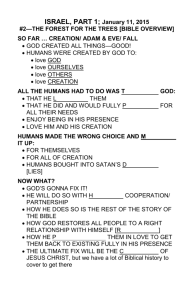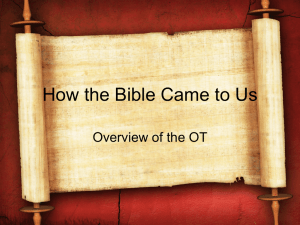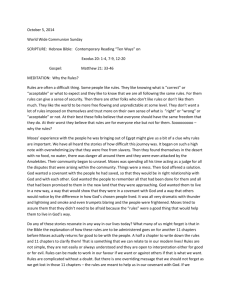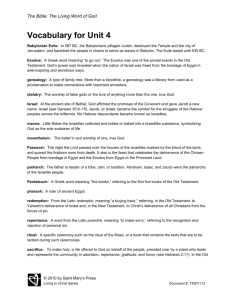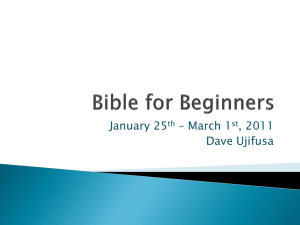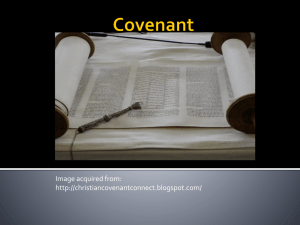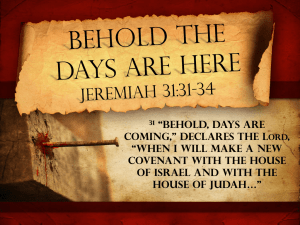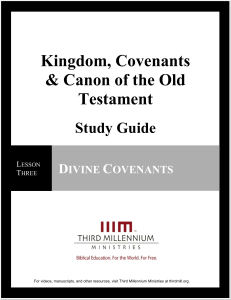Bible Basics 1 - The Garden Gathering
advertisement
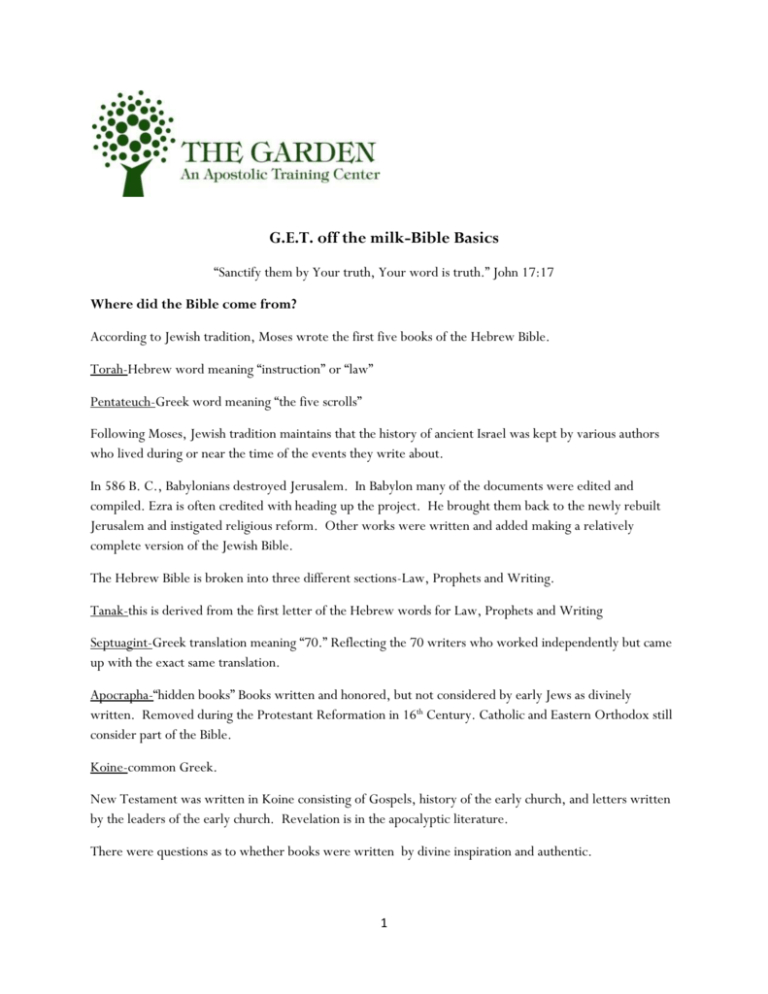
G.E.T. off the milk-Bible Basics “Sanctify them by Your truth, Your word is truth.” John 17:17 Where did the Bible come from? According to Jewish tradition, Moses wrote the first five books of the Hebrew Bible. Torah-Hebrew word meaning “instruction” or “law” Pentateuch-Greek word meaning “the five scrolls” Following Moses, Jewish tradition maintains that the history of ancient Israel was kept by various authors who lived during or near the time of the events they write about. In 586 B. C., Babylonians destroyed Jerusalem. In Babylon many of the documents were edited and compiled. Ezra is often credited with heading up the project. He brought them back to the newly rebuilt Jerusalem and instigated religious reform. Other works were written and added making a relatively complete version of the Jewish Bible. The Hebrew Bible is broken into three different sections-Law, Prophets and Writing. Tanak-this is derived from the first letter of the Hebrew words for Law, Prophets and Writing Septuagint-Greek translation meaning “70.” Reflecting the 70 writers who worked independently but came up with the exact same translation. Apocrapha-“hidden books” Books written and honored, but not considered by early Jews as divinely written. Removed during the Protestant Reformation in 16th Century. Catholic and Eastern Orthodox still consider part of the Bible. Koine-common Greek. New Testament was written in Koine consisting of Gospels, history of the early church, and letters written by the leaders of the early church. Revelation is in the apocalyptic literature. There were questions as to whether books were written by divine inspiration and authentic. 1 Canonization-Greek word meaning “rule” or “measure.” By the end of the second century most of the books that now make up the New Testament were determined to be authentic. How did we get the Bible? We don’t have any original copies of the original manuscripts. They were written on papyrus which didn’t have a great shelf life. Just because we don’t have the originals doesn’t mean we don’t have accurate copies. In the case of the New Testament we have thousands of handwritten manuscripts of the books allowing scholars to determine what the earliest manuscripts. According to Jewish sources, manuscripts were copied with utmost care, and even the most minor errors had to be fixed or a manuscript was discarded. Masoretic Text-oldest copies of Hebrew Bible written by sect of Masoretic Jewish scribes. In 1947, as the story goes, a young shepard boy was watching his flock when he threw a rock in an attempt to corral his straying sheep. His rock flew into a cave and landed with a crash. Entering the cave, the shepherd saw something that would change study of Bible forever. He discovered a stash of 2,000-year-old scrolls of the Bible and other ancient writings stored in ceramic pots. Where was it written? Asia, Africa, Europe. Written over 1500 year period. Names you can check out: John Wycliff-translated Bible from Latin to English William Tyndale-first New Testament to English from Greek Martin Luther-Protestant Reformation Thomas Matthew-translated first entire Bible in English One Sentence sums it up well“The Bible tells the story of God and His relationship with His creation-most particularly, human kind-which He initiates through a series of covenants.” Covenant-an agreement or contract that obligates one or more parties to fulfill specific promises or duties. Understanding the Covenant A covenant is defined as, “a usually formal, solemn, and binding agreement: COMPACT, a written agreement or promise usually under seal between two or more parties especially for the performance of some action.” Webster’s Ninth New Collegiate Dictionary 2 God’s covenant is based out of ‘perfect love’, to a thousand generations. His heart’s desire if for relationships that are never ending. “Know therefore, that the Lord your God, He is God, the faithful God, who keeps His covenant and His loving kindness to a thousand generations with those who love Him and keep His commandments.” Deut. 7:9 History of Covenants For generations blood covenants have been made. Covenants are very foreign to the Western world. Covenants required loyalty, integrity, faithfulness and unbreakable relationships. “Covenant agreements were entered into to bind two tribes together. The grounds for this union were always based on their differences, not their similarities. Since the covenant agreement was entered based on differences and not similarities, their strengths and weaknesses balanced each other out. This union made both tribes strong. During negotiations, the two families agreed to each party’s responsibility in the union. They agreed upon a blessing for keeping the terms as well as a curse for breaking them. The fear of the curse and the desire to benefit from the blessing kept the parties in line. Then each family chose a representative. The representative was one who had the very character of the family. If the family were strong warriors, the representative was the greatest and most highly skilled warrior of them all. If the family were business-minded, the representative was the most shrewd business person in the family. The representative was always someone with whom the whole family could identify. He was also someone with whom outsiders identified the family. Next, they chose a covenant site. Family members would gather together to watch the rite take place. After the site was chosen, the sacrificial animals were selected. They were most often large animals who would shed a great deal of blood when they were slaughtered. The animals were cut from the back of the neck down the backbone. The two halves fell to the ground, laying opposite of each other. Their blood spilled on the ground between the two halves, and the alley between them was customarily called the walkway of blood. As the covenant ceremony began, each representative removed his coat and exchanged it with the other representative. The coat represented the strength and authority of each family. By exchanging coats, they symbolically exchanged authority. Then they exchanged their weapons belts which meant that they would fight one another’s battles for them. After the exchange of coats and weapons belts, the representatives stated the terms of the covenant. Then comes the walk of blood. The representatives walked between the two animal halves and stood in the midst of the blood and made irrevocable promises and stated the curse or penalty for breaking the promises. [due to man’s imperfection, a covenant could be broken and that is why they had ‘curses’ if it was broken.] Covenants were cut and blood was shed so that the promises 3 would make a deep and lasting impression on the memories of each of the family members. Also, a very impressive procedure, the covenant representatives then cut themselves either on the wrist or the hand in order to mingle their blood together. This signified that the two were actually one, having the same blood. They lifted their arms so that everyone could see the cuts. Then they swore oaths by their gods. Either gunpowder or some other substance was rubbed into the cut to make the scar that much more outstanding. The purpose of this was to affect the memories of the families. That awesome, ugly scar would forever remind them of the promises that they had made to each other. Then the two families exchanged their names. Actually, they joined their names together. They also exchanged their friendship. Then came a covenant meal of bread and wine. This was the grand finale of the covenant rite. The bread represented the body, and the wine represented the blood. The meal of the bread and wine symbolized each family giving themselves to the other family even to the point of dying for one another if need be. They ate ‘in remembrance’ of what they did that day in cutting covenant together.” Taken from, Covenant Made by Blood, by Kenneth Copeland. What’s the difference between the Old and New Testaments? Imagine the difference between how you treat your children. When they are young, like the nation of Israel was, you must keep them under law and correction to train them. When they mature, you walk with them as a friend and companion whom you guide in a different way based on their maturity. We must honor and heed every part of God’s Word. Jesus didn’t come to get rid of the Old Testament, but to fulfill it. Matthew 5:17 Old Testament Law vs. New Testament (Exodus 20) Grace (Matthew 5:21) Judgment Mercy Leper touches you-you become unclean Jesus touches leper-leper becomes clean They are like a last will and testament. Jesus had to die so we could get our inheritance. The New Testament can be seen as Jesus Bridal contract with us. Ketubah-marriage contract with promises for us from our Bridegroom. Groom presents contract to bride’s father. Groom goes to prepare a place for them to live and his father must approve before the groom can go collect his betrothed wife. 4 Old Testament-before Jesus as a person on earth History-Israel entering promised land, into captivity, to partial restoration as a nation Genesis, Joshua, Judges, Ruth, 1&2 Samuel, 1&2 Kings, 1&2 Kings, Ezra, Nehemiah, Esther Law-Creation, development of Israel, God’s special instructions to His special people Exodus, Leviticus, Numbers, Deuteronomy Wisdom and Poetry Job, The Psalms, Proverbs, Ecclesiastes, Song of Solomon Major Prophets-Outstanding Prophets over history of Israel Isaiah, Jeremiah, Lamentations, Ezekiel, Daniel Minor Prophets-Shorter books, strategic times in history of Israel Hosea, Joel, Amos, Obadiah, Jonah, Micah, Nahum, Habakkuk, Zephaniah, Haggai, Malachi, Zechariah New Testament-during and after Jesus on earth and His return Gospels-Histories of the Life of Jesus Matthew, Mark, Luke, John Church History-Record of the spread of Christianity Acts Pauline Epistles-Letters Paul wrote to a church or person for special purpose Romans, 1&2 Corinthians, Galations, Ephesians, Phillipians, Colossians, 1&2 Thessalonians, 1&2 Timothy, General Epistles –Written to a person or group not met reached by Paul James, 1&2 Peter, 1,2&3 John, Jude Prophecy Revelation How do I use it? Read it as a library with lots of books 5 Read a single book, chapter, verse, word and think/pray/listen about what it means. How do I look things up? The name of the books in order is in the very beginning called the “Table of Contents.” The names of the books are at the tops of the pages. The big numbers are chapters and the little numbers are verses. Verses are like sentences or groups of sentences like in a poem sometimes. Like a dictionary, the chapters and verses are in order at the top of the page by the name of the book. 6
